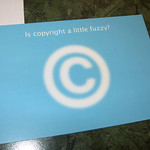
In April 2013, I heard
Forrest Foster speak at the
Computers in Libraries Conference, where he talked on "Blog Talk Radio: Connect, Collaborate & Enthuse!" (
notes). Forrest has started his own
broadcast/podcast on the topic of learning spaces. The
show (podcast) is done during the academic year and there are now nine episodes.
Learning spaces (or learning commons) were started in some academic libraries in the 1990s. As Dr. D. Russell Bailey, Library Director of Phillips Memorial Library+Commons at Providence College, said in the first Let's Talk Learning Spaces Show they don't have to be expensive. Yet many universities and colleges do spend money on new or improved spaces and equipment.
At Johns Hopkins University, the
Brody Learning Commons "is also home to the Department of Special Collections and the
Department of Conservation and Preservation." This means that these learning spaces can be a connection to historic materials as well as to new technology. That easier connection between the digital and the physical can provide a means for students to see physical objects and not just rely on the digital images. Imagine a student viewing a digital version of an object that the library owns, and having a message pop-up that says that the real object is being retrieved for the student to view. That may be unrealistic in many instances, but wouldn't it be interesting if that could occur even some of the times?
Below is a 2013 video from
Old Dominion University about its learning commons, which shows beautiful spaces and new equipment. Again, not every learning space needs to be build with all new equipment, etc. SUNY Geneseo initially built its learning commons using what it had and incorporating some new elements. Yes, it can be done if you understand what you are trying to achieve and built the correct partnerships.
 The ALA Committee on Professional Ethics (COPE) is developing a "proposed interpretation of the ALA Code of Ethics on the topic of copyright." This interpretation will be considered by the Council at the 2014 ALA Annual Conference in June. The proposed interpretation is now open for comments on the ALA Connect web site. Please take a moment to read it and leave comments on that site to note anything that you believe needs clarification. It is also important for you to speak up, if you disagree with any part of the text.
The ALA Committee on Professional Ethics (COPE) is developing a "proposed interpretation of the ALA Code of Ethics on the topic of copyright." This interpretation will be considered by the Council at the 2014 ALA Annual Conference in June. The proposed interpretation is now open for comments on the ALA Connect web site. Please take a moment to read it and leave comments on that site to note anything that you believe needs clarification. It is also important for you to speak up, if you disagree with any part of the text. 